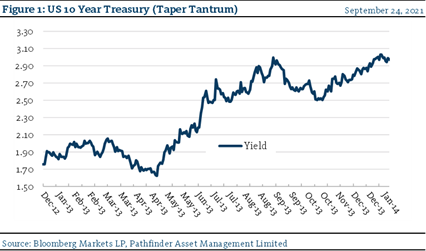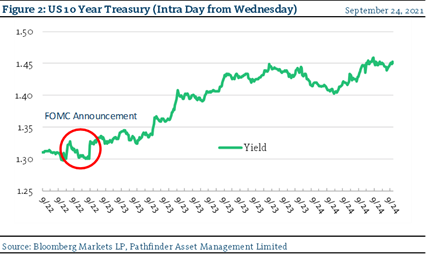Taper Truce?
This week, there was a well-publicized meeting of the US Federal Open Market Committee (FOMC), which is a group of US Federal Reserve Bank governors that collectively set interest rate policy for the United States. As I am sure that everyone is aware, administered interest rates have been at structurally generational lows (around the world) since the Great Recession, when they were lowered to essentially zero in the fall of 2008. They did increase somewhat from 2016 through 2018 but were cut to effectively zero again in the spring of 2020 at the start of the pandemic.
Part of the toolbox that the FOMC uses to help manage the level of interest rates, beyond the very short-term overnight rate that it sets at the FOMC meeting, is Quantitative Easing (QE). Purchasing longer dated securities in the open market to have the dual impact of adding both liquidity and lowering interest rates is colloquially referred to as “QE”. The following change was made to the most recent FOMC communique “…. the committee judges that a moderation in the pace of asset purchases may soon be warranted.” This is effectively putting markets on notice that the FOMC will be reducing purchases or QE.
- Figure 1 presents what happened to US interest rates when the FOMC indicated the same thing in 2013. This is what is collectively referred to as the “Taper Tantrum”.

- As interest rates increase, the value of long-term assets (ie stocks) can be impaired, so the quick change in messaging resulted in a significant amount of market volatility.
- Figure 2 presents what happened intra-day at the time that the FOMC announced that asset purchases would moderate. Initially rates went down, which caused some head scratching on the desk. Subsequently they have gone up, in a very orderly This is somewhat of a different reaction than in 2013 and it appears that there is still a debate about how sustainable the QE will be.

“This means that” we will keep watching this closely, as always, but we can expect some volatility over time as these very significant long-term forces work themselves toward some form of normalization. We will still buy great companies at good prices; however, financial markets will continue to react to the adjustments that governments will make on both a monetary and fiscal basis in these unprecedented times.
National Instrument 31-103 requires registered firms to disclose information that a reasonable investor would expect to know, including any material conflicts with the firm or its representatives. Doug Johnson and/or Pathfinder Asset Management Limited are an insider of companies periodically mentioned in this report. Please visit www.paml.ca for full disclosures.
*All returns are time weighted and net of investment management fees. Returns from the Pathfinder Partners’ Fund and Partners’ Real Return Plus Fund are presented based on the masters series of each fund. The Pathfinder Core: Equity Portfolio and The Pathfinder Core: High Income Portfolio are live accounts. These are actual accounts owned by the Pathfinder Chairman (Equity) and client (High Income) which contain no legacy positions, cash flows or other Pathfinder investment mandates or products. Monthly inception dates for each fund and portfolio are as follows: Pathfinder Core: Equity Portfolio (January 2011), Pathfinder Core: High Income Portfolio (October 2012) Partners’ Fund (April 2011), Partners’ Real Return Plus Fund (April, 2013), and Partners’ Core Plus Fund (November 2014).
Pathfinder Asset Management Limited (PAML) and its affiliates may collectively beneficially own in excess of 10% of one or more classes of the issued and outstanding equity securities mentioned in this newsletter. This publication is intended only to convey information. It is not to be construed as an investment guide or as an offer or solicitation of an offer to buy or sell any of the securities mentioned in it. The author has taken all usual and reasonable precautions to determine that the information contained in this publication has been obtained from sources believed to be reliable and that the procedures used to summarize and analyze such information are based on approved practices and principles in the investment industry. However, the market forces underlying investment value are subject to sudden and dramatic changes and data availability varies from one moment to the next. Consequently, neither the author nor PAML can make any warranty as to the accuracy or completeness of information, analysis or views contained in this publication or their usefulness or suitability in any particular circumstance. You should not undertake any investment or portfolio assessment or other transaction on the basis of this publication, but should first consult your portfolio manager, who can assess all relevant particulars of any proposed investment or transaction. PAML and the author accept no liability of any kind whatsoever or any damages or losses incurred by you as a result of reliance upon or use of this publication.